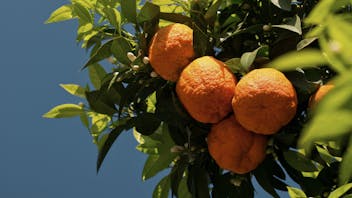Product Overview
Our organic Petitgrain Bigarade has a fresh, leafy-green, lightly floral, citrus aroma with light bitter/dry notes and rich, sweet undertones. This essential oil's Neroli-like aroma has made it a classic ingredient of Eau de Cologne formulas.[1]
Petitgrain Bigarade essential oil is steam distilled from the leaves and twigs of a specific evergreen tree that also provides five other oils - from the blossoms: steamed distilled Neroli and solvent extracted Orange Blossom Absolute; from the leaves: solvent extracted Petitgrain Absolute; from the leaves, twigs, and blossoms: steam distilled Petitgrain sur Fleurs; and, expressed from the fruit peels: Bitter Orange oil.
Since the 1860s when nearly all citrus orchards, except for Bitter Orange trees, were destroyed due to root rot and gum disease, it has been the practice to use the highly resistant root stock of this specific citrus, Citrus aurantium var. amara, to propagate Lemon, Sweet Orange, Mandarin, Grapefruit, and Bergamot trees.[2] Petitgrain Bigarade is a subspecies of the sour or Bitter Orange, Citrus x aurantium L., with 'bigarade' denoting it as the true sour, true bitter (bigarade) or Seville Orange subspecies.[3]
Petitgrain has been called “poor man’s Neroli” as it is less expensive than Neroli essential oil yet offers many of the same benefits and uses. Due to its high linalyl acetate content, the aroma of Petitgrain is often used in calming massage blends, nighttime sprays and diffuser blends, after-shaves, and preparations for oily and congested skin.
1 Lawless, Julia. The Illustrated Encyclopedia of Essential Oils, 1995, p. 118.
2 Guenther, Ernest. The Essential Oils, Vol. III, 1949, pp. 89, 228.
3 Ibid, p. 203.



